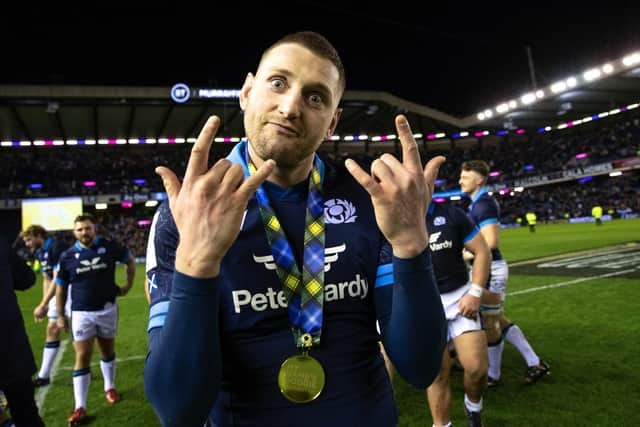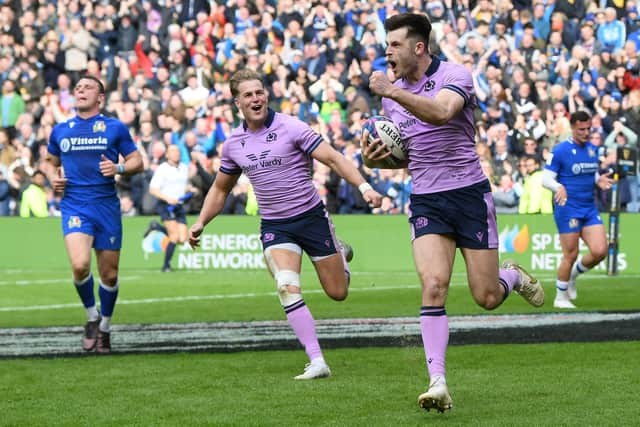Six Nations: 8 Scotland talking points - glass ceiling, flying Finn Russell and Blair Kinghorn conundrum
Three wins is Scotland’s glass ceiling
For the fourth time in six campaigns, Gregor Townsend led Scotland to three victories from five games in the Six Nations. It was enough to finish third but the coach will rue the horrible start in Paris which meant his side were always playing catch-up against a French team they had the beating of. Scotland have never won more than three in a single season since the championship was expanded to include Italy in 2000. And to put Townsend’s achievements in perspective, they only managed the hat-trick of wins twice in the 18 seasons before he took charge, under Frank Hadden in 2006 and Vern Cotter in 2017. Townsend is banging away at the glass ceiling but it is proving hard to break through.
Townsend not afraid to make the big calls
The Scotland coach was uncharacteristically consistent with his team selections, most notably in picking the same backline for four games in a row before injury intervened. But that doesn’t mean he didn't make some bold calls. Ali Price and Chris Harris have been staples of Townsend teams for years and years but both were reduced to bit-part roles. Price was excluded entirely from the match-day 23 for the games against England and Wales and had to be content with a place on the bench in the final three matches as Ben White seized his chance at scrum-half. Similarly, Harris found his place at outside centre taken by Huw Jones as Townsend placed the emphasis on attack. Harris made late substitute appearances against England, Wales and Ireland, with his time on the field totalling just 13 minutes. The form of White and Jones (the centre scored four tries and combined superbly with Sione Tuipulotu) proves Townsend’s quiet revolution was a success.
Flying Finn Russell is creativity incarnate
Advertisement
Hide AdAdvertisement
Hide AdTownsend’s decision to exclude Finn Russell from his original Autumn Nations Series squad becomes more incredible with each passing day. Unless, of course, it was a cunning ruse to jolt the player into greater feats, a metaphorical kick up the backside. The only trouble with this theory is that Russell doesn’t seem the type to be hoodwinked in that way. Happily, the coach now views the stand-off as essential while the player says he and Townsend “are on the same page”. This Six Nations proved how fundamentally important it is that their relationship remains intact for the World Cup. Russell had an outstanding championship, leading the Scotland attack with speed, imagination and maturity. They simply weren’t the same team when he was absent for the final game against Italy.
The Blair Kinghorn conundrum


Blair Kinghorn started one match, came on as a sub in the other three and ended the championship as Scotland’s joint top try-scorer, with four. The stand-off-cum-wing-cum-full-back was on the field for a total of 187 minutes so averaged a try every 47 minutes. With stats like that it’s hard to see him being anything other than a key member of the Scotland team at autumn’s Rugby World Cup. But are we any nearer to pinning him down to one position? Perhaps. After almost two years of trying to convert him into a stand-off, Townsend acknowledged after the Italy game that Kinghorn was “pushing more for the back three positions than 10”. The Edinburgh back started at stand-off against Italy and scored a hat-trick so that might seem a harsh assessment but his delivery was nowhere near as slick as Russell’s. Kinghorn’s pace, athleticism and footballing skills are huge assets and would be better utilised at wing or full-back, but he’s a handy option as a back-up 10.
Huwipulotu takes centre stage
What started as a bit of fun on Twitter morphed into Scotland’s most creative midfield since the 1999 title-winning season. Huw Jones and Sione Tuipulotu had played together for Glasgow only three times before the Six Nations kicked off but Warriors fans knew it was a winning combination. Gregor Townsend agreed and selected the pair as his starting centres in the Calcutta Cup. They delivered immediately, Tuipulotu threading through a delicate grubber for Jones to latch on to for the opening try in (another) famous Twickenham win. They never looked back. The pair started every match and Jones ended as Scotland’s joint highest try-scorer, on four. Three of them were created by Tuipulotu who had an outstanding tournament in between Russell and Jones, and was a surprising omission from the Guinness Six Nations Player of the Championship short-list.
Back row provides bonanza of options


A traditional area of strength for Scotland, the composition of the back row is a little more fluid these days. Jamie Ritchie was the only constant during the Six Nations, the captain playing every minute of every game. He was partnered by Luke Crosbie and Matt Fagerson in the first two matches (England and Wales); Hamish Watson and Fagerson in game three (France – although Watson was sacrificed after ten minutes when Grant Gilchrist was sent off); Fagerson and Jack Dempsey in game four (Ireland) and Watson and Dempsey in the final match, against Italy. Throw Rory Darge into the mix and Townsend is left with five players vying for two positions at the World Cup if we assume Ritchie is a nailed-on starter. Darge didn’t play in the Six Nations as he continued his comeback from a serious ankle injury but he did join the squad for the final two matches and will be a major contender for the No 7 jersey if he finds his form. Dempsey finished the tournament strongly, Fagerson started it very well and Watson had a frustrating time of it for the most part, largely through no fault of his own. Lots of good options for Townsend.
The inactive eight
Consistency of selection meant some players were left kicking their heels on the sidelines for most of the championship and there were an unlucky eight who never saw a minute of action. Among the inactive players was Bath wing Ruaridh McConnochie, whose inclusion dominated the news when Townsend named his Six Nations squad way back in mid-January. McConnochie, London-born to Scottish parents, won two caps for England in 2019 but was able to switch due to World Rugby rules which allow a capped player to change allegiance if they are eligible after a three-year cooling off period. Unfortunately for the 31-year-old, the form of Duhan van der Merwe and Kyle Steyn kept him out of the team. He wasn’t the only one. Fellow backs Stafford McDowall and Sean Maitland never made a match-day squad and neither did forwards Dave Cherry, Javan Sebastian, Josh Bayliss, Cameron Henderson and Andy Christie.
What lies beneath?


If the general consensus was that Scotland enjoyed a good championship, it was a sobering campaign at times for the under-20 team who suffered a record 82-7 loss to Ireland at Scotstoun, a horrible result which should serve as a reality check for the state of the game at grassroots level. Those in charge of rugby development at Murrayfield talk of providing “a pipeline” of talent for the national team but the supply has been reduced to a trickle in recent seasons, with Townsend relying increasingly on the ‘Scottish-qualified’ programme, ie players reared elsewhere with familial connections to Caledonia. Only half his Six Nations squad came through the Scottish system and there is little sign of that improving any time soon, which should set alarm bells ringing for the long-term future.
Comments
Want to join the conversation? Please or to comment on this article.
